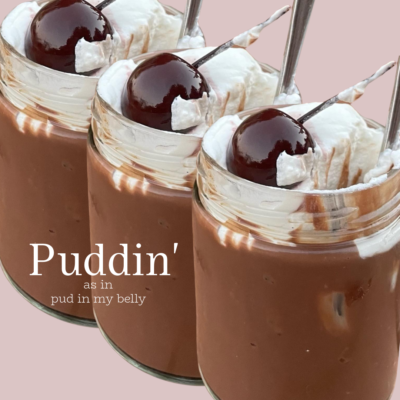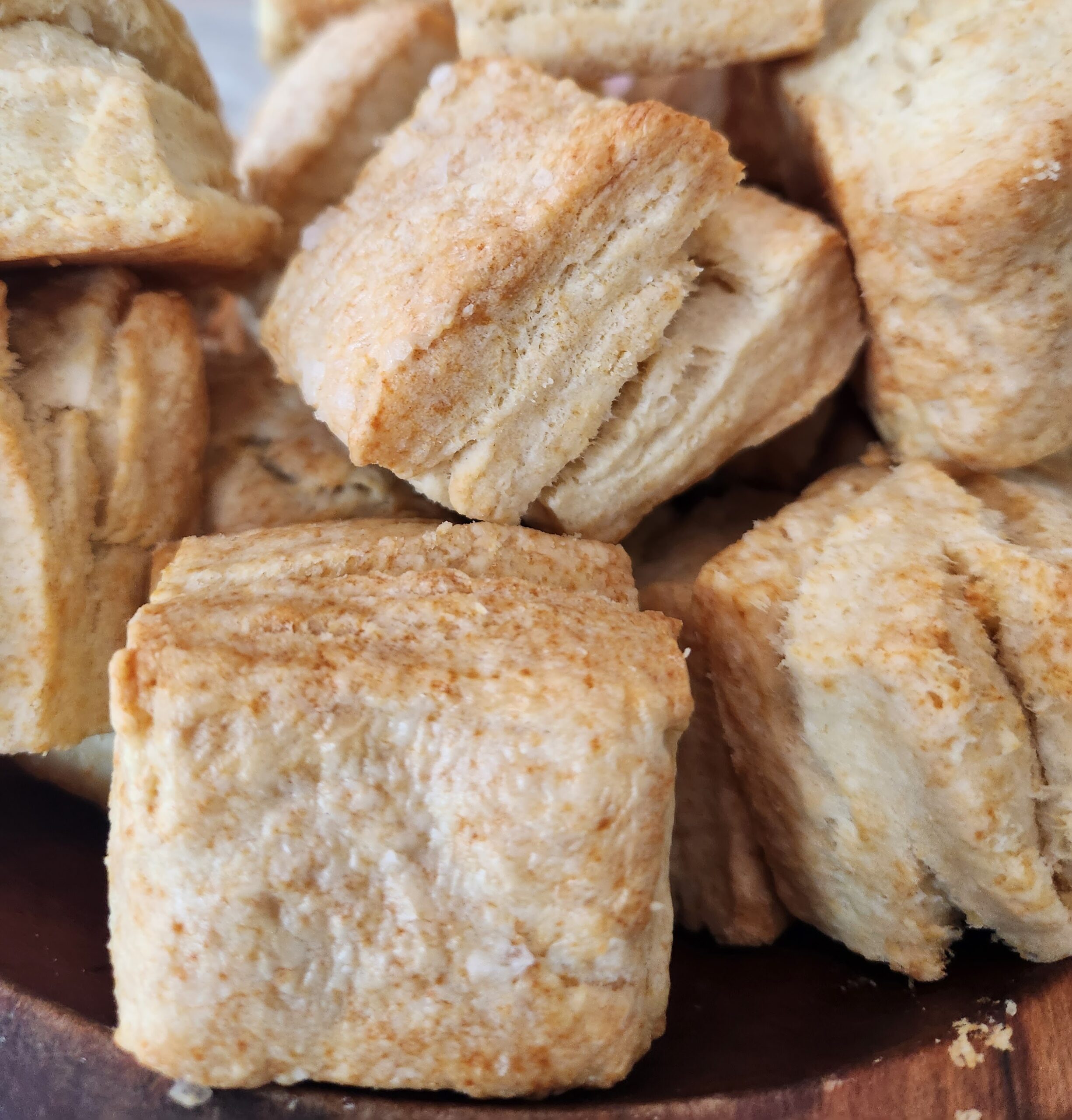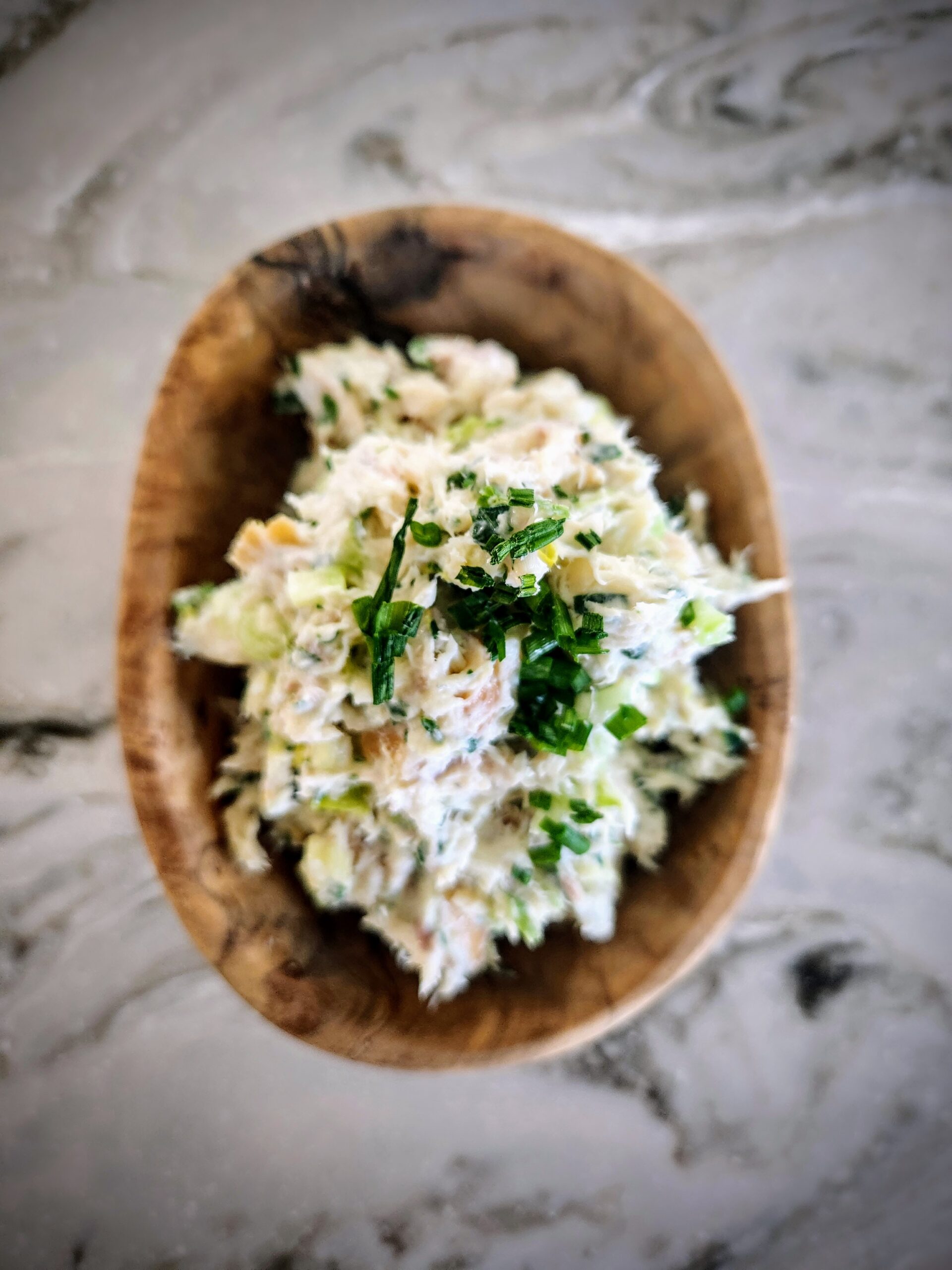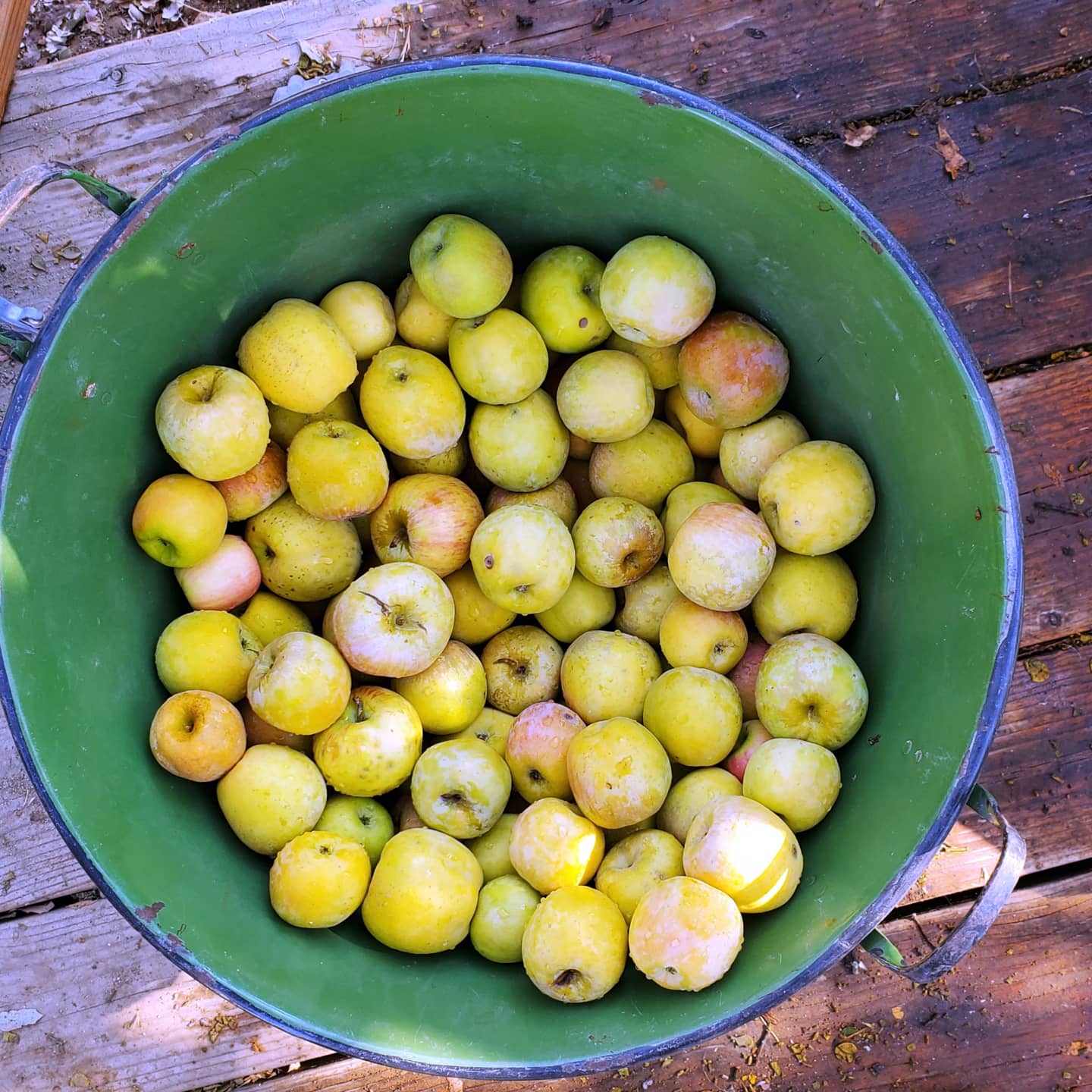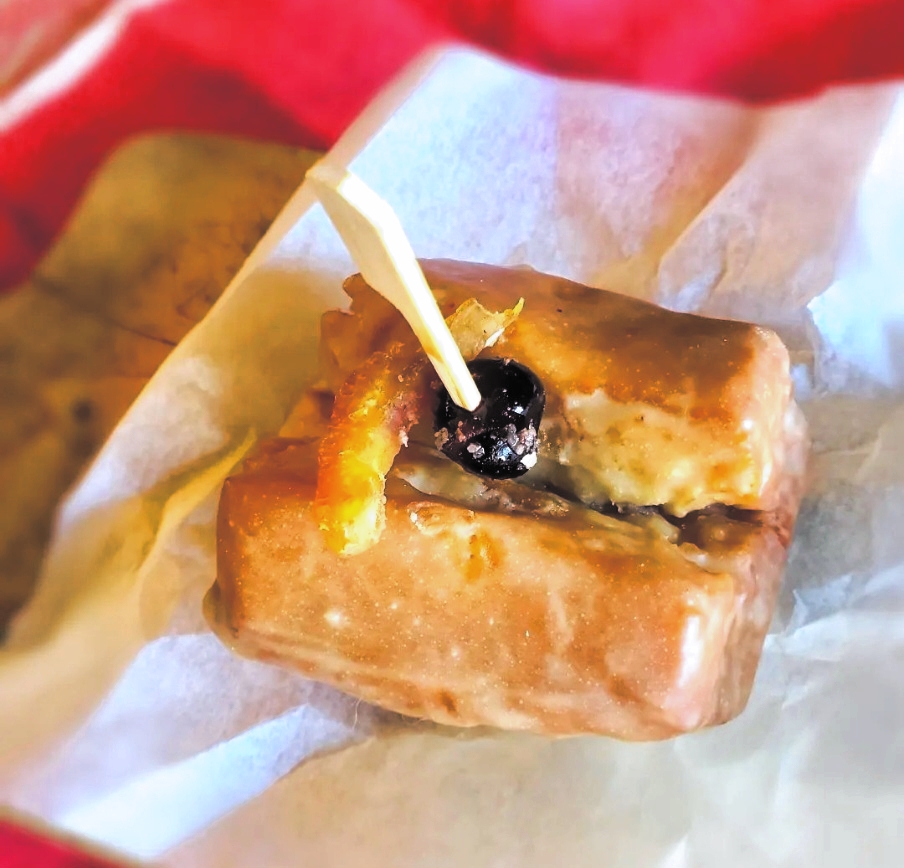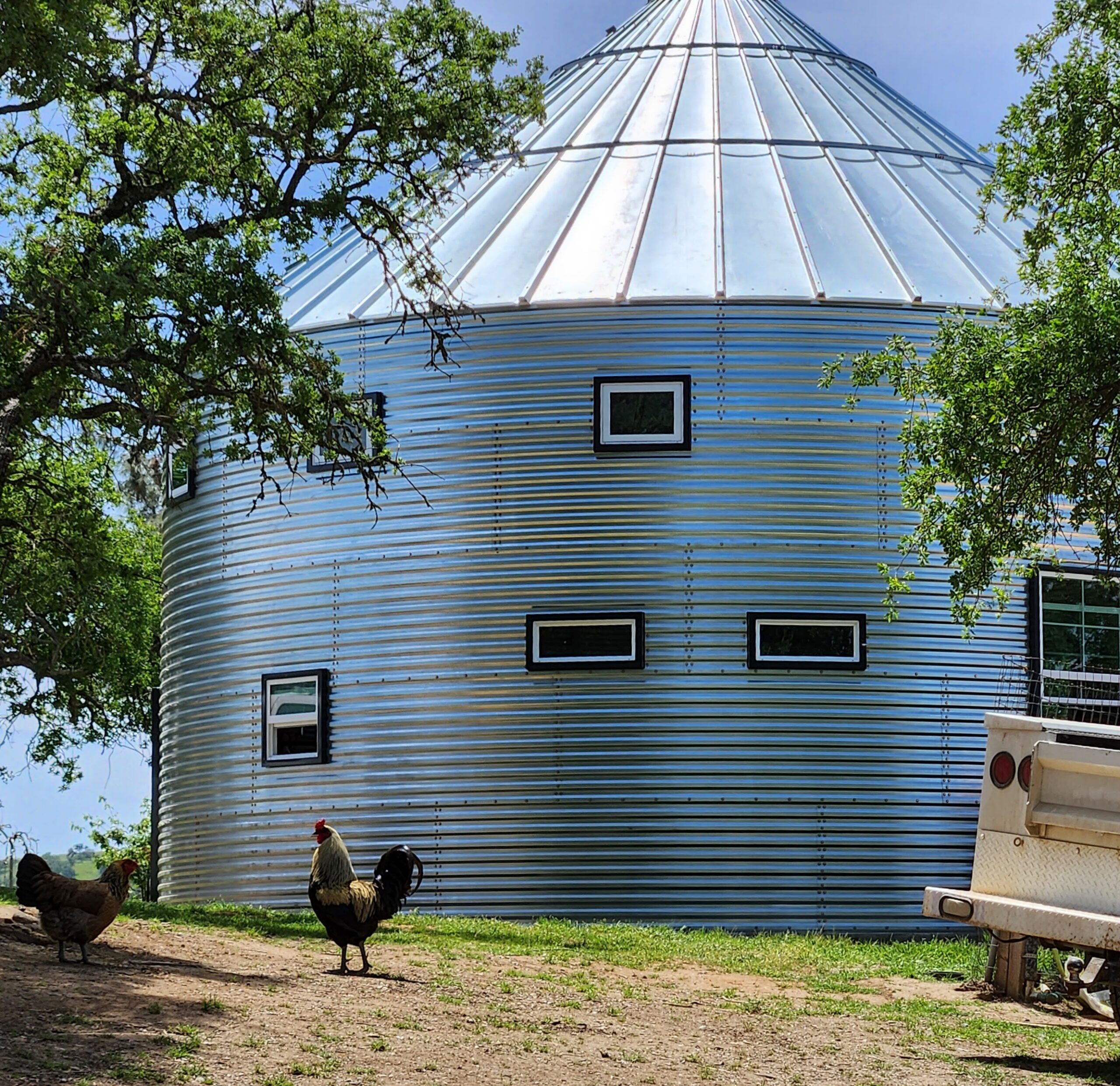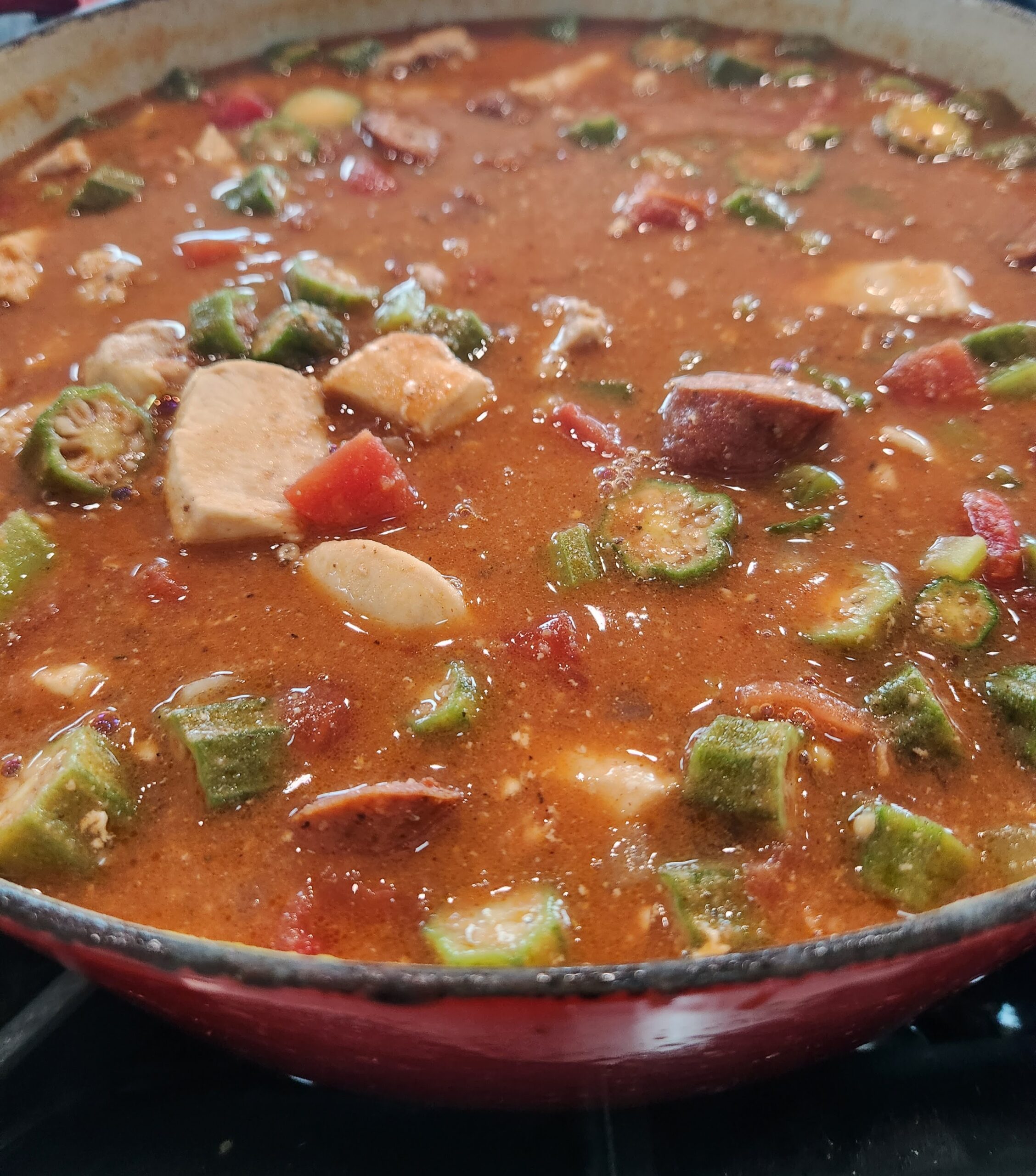
Chicken and Sausage Gumbo
On October 6, 2019 by Christy LarsenI’m not claiming authenticity here. I mean, this has the elements of a classic gumbo, but then I took a bit of a turn with adding bloody mary mix. I like the ease of it, and it tastes good.
There is a short window of time here on the Central Coast where hot stew-like foods coexist with the harvest of okra. That window is now. While our days are still warm, our mornings and overnights are cool enough to crave the warm embrace of this spicy gumbo. And this is spicy. If you find it a bit overwhelming for you, dial back the additional cayenne, and add a dash or two of vinegar in place of the tabasco. You can also dilute a bit more with the chicken stock. If it really, really is too much, add a bit of yogurt or sour cream to your individual bowl to draw the spice back a bit; authentic, no, but we’ve already established that.
My gumbo spice mix is Emeril’s spice mix from his New Orleans’s Cooking book, with just an addition or two on my part. It’s a nice spice to keep around to add a bit of oomph to soups or even baked chicken.
Gumbo Spice
2 TBS Chili Spice & Paprika
1 TBS Ground Coriander, Garlic Powder, Onion Powder, Kosher Salt
2 tsp Ground Cumin
1 tsp Cayenne Pepper, Crushed Red Pepper, Dried Oregano, Dried Thyme, & Black Pepper
Mix and keep in an airtight container
Chicken and Sausage Gumbo
1 1/2 LBS Boneless/Skinless Chicken cut into cubes (I use a mixture of thigh and breast)
2 CUPS Chicken Stock
2 TBS Gumbo Spice
4 Andouille Sausage links–cut crosswise into pieces
1/4 cup flour
2 CUPS sliced okra (fresh or frozen)
1 Medium Onion–chopped
3 Stalks Celery–chopped
1 Green Pepper–chopped
3 Cloves Garlic–chopped
14 oz can Diced Tomatoes–undrained (or the equivalent of diced in-season tomatoes)
1 cup Mr & Mrs T’s Spicy Bloody Mary Mix
2 bay leaves
1/2 cup Scallions–sliced
2 tsp (or more) Worcestershire Sauce
1/2 tsp Dried Thyme
1 tsp Kosher Salt
1/2 tsp Black Pepper
1/2 tsp White Pepper
1/4 tsp Cayenne
2-4 Dashes Tabasco
Olive Oil
Cooked Steamed Rice to Serve
Brown the sausage in a little bit of olive oil. Keeping the heat on medium, remove the sausage with a slotted spoon and add the chicken pieces. Cook until browned on all sides, then sprinkle with the Gumbo Spice. Remove from pan with a slotted spoon and add to the sausage. Add more oil to the fat in the pan resulting in about 1/4 cup in total. Staying on medium-high heat, add the flour and stir until the mixture reaches a medium-brown hue. When it is brown turn off the heat and quickly add okra, onions, garlic, celery, and green pepper. Allow the sizzling to stop, then add chicken stock, stir while scraping all the bits off the bottom of the pan. Add Mr & Mrs T’s, tomatoes, green onions, bay leaf, thyme, black pepper, white pepper, and cayenne. Bring to a boil, then reduce to a simmer. Add back the chicken and sausage and let simmer for at least an hour. The longer it simmers the better. Taste for salt and spice level; adjust as necessary
Serve with or without rice, and add Tabasco as desired.
Serves 6-8
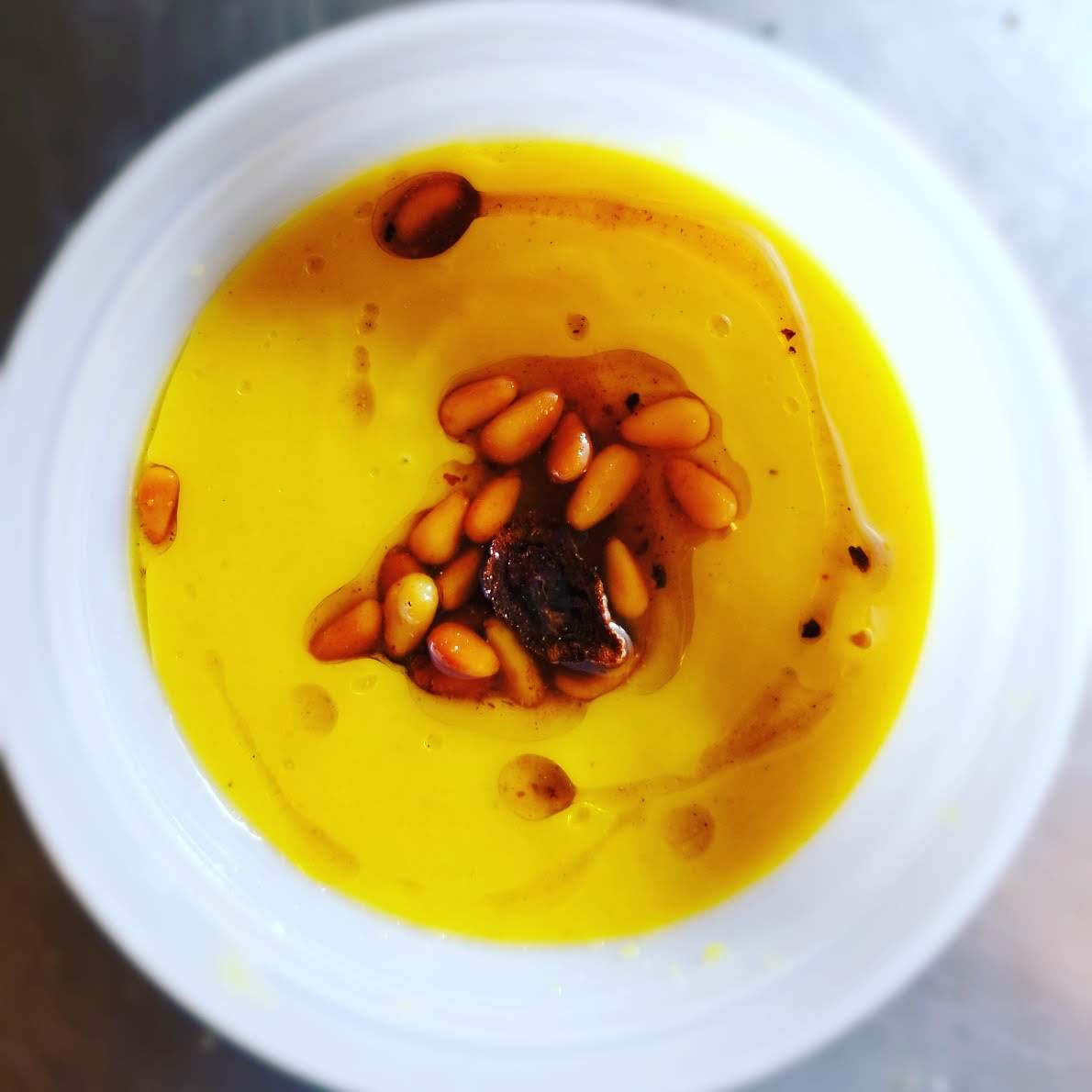
Squash Soup
On October 5, 2019 by Christy LarsenEvery year we grow pumpkins and squash in our gardens. It is always a bit of a
This past year we had good success with the Boston Marrow Squash. It is big and orange like a pumpkin, but it is not round and begging to be carved for
The Boston Marrow was once a very popular variety which was sold commercially. Its flesh is a bit dry and sweet. I believe it is in the
Our root cellar is not quite finished, so we have been storing our squash and pumpkins on the back porch. I do not recommend this. It is actually a horrible idea. My hope is that I will get through them all before the hand of time takes them away from me (or even worse, those dreaded squirrels).
I wish I had an actual recipe for you…but I never measure and I use what I have on hand. Hopefully, you will feel inspired to do the same.
Here is how it went:
Peel and cut about your squash (or pumpkin) into 1/2″ size cubes–about 3 cups…but as many cups as you would like. I like to match the number of cups of squash to cups of stock (or water). For every 3 cups of squash, finely dice 1/4 of an onion and 1 garlic clove.
In a stockpot, put enough olive oil to just coat the bottom. Toss in the onion and garlic and slowly cook until they are soft. If you see them starting to brown, add a bit of stock or water (an ounce or two) to stop the cooking. Stir in 2-3 Tbs curry powder, 1/2 tsp ground cumin & 1/2 tsp paprika. Let the paste get a bit cooked. Add to this the squash and give it a nice stir. Add your stock/broth/water to cover the squash. Grate 1/4 of an apple into the mixture (more if you’d like a bit more sweetness). Cook until everything is soft.
Remove from heat and run the mixture through a blender or use an emersion stick to fully puree the mixture. At this
Rinse your stockpot and then put it back on the stove and pour your puree back in. Turn the heat on low. This is where you start futzing. Add a tsp or so of Braggs, a little black pepper, additional curry powder if you think it needs it. Salt if it needs it. If it is too thick, add more stock/water…if it is too runny, let it cook a bit to reduce.
To Top: put some olive oil in a small saucepan…maybe 1/4 cup. Toss in a tsp of curry powder, a pinch of red pepper flakes a handful of dried onions, or fresh onions, or onion powder and a handful of pignoli nuts. Cook until hot and the flavors are melded.
To serve: Put the soup in a bowl and top with your delicious curry pignoli oil. Ta Da!

Harvesting Roosters
On February 6, 2019 by Christy LarsenLet me start at the beginning
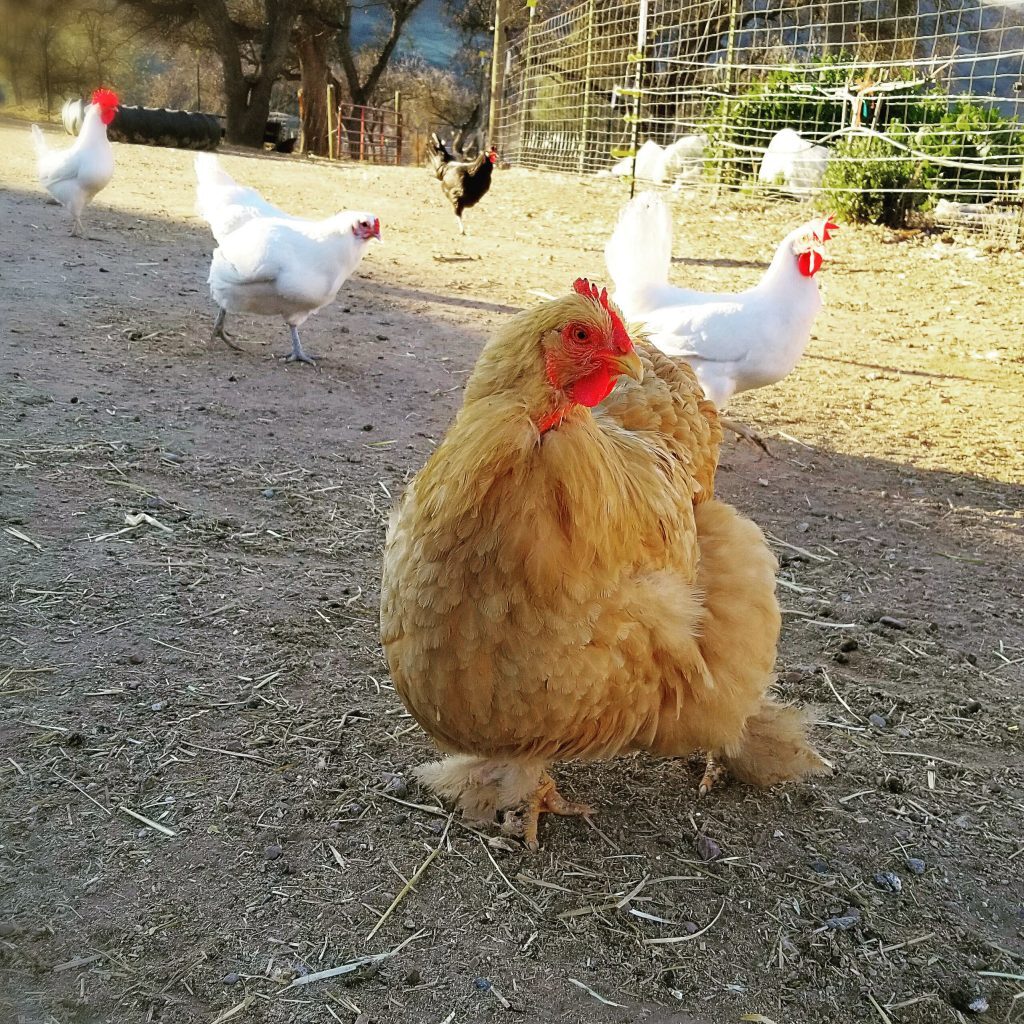
Our first set of chickens arrived via the afternoon mail and we were giddy upon their arrival. We did all of the things one does with new chicks, including daily health check and brooder cleanings. Fast forward several months and we moved them to their new coops. We had placed several moderately sized coops throughout our property and built a larger barn style coop for the bulk of the birds. We named many of our favorites, and moved to singularly naming a breed {our barred rocks for example were all named roseanne}, when we realized that we were using up “all the good names”, and we would soon have sheep, goats, dogs and pigs to name. I fussed over them and essentially took role-call each sundown.
We had placed coops throughout our property, including a large barn with a automatic door. We were obsessed with doing everything right. Making sure every chicken got back into a coop in the evening., double-triple checking everything was perfect. We also monitored broody hens {broody hens are those that will sit on eggs in the hope of bringing chicks into the world}, to make sure they didn’t hatch out any chicks.
That was how we started.

Fast-forward to today.

These chickens can fly.; not launch and fly away, fly, but fly to the top of fence lines, barn roofs, or to the top of a car.
And they do.
It didn’t take long for them to abandon the coops and scatter themselves throughout the property finding interesting places to roost overnight; most notably, in the trees.
These same chickens have access to 60 acres and countless places to be broody and hide clutches of eggs.
And they do.
Just as the weather starts to warm, I notice chickens disappearing for months at a time only to reappear with a large brood of their own. We welcome this, it is a great way to support natural selection. It transfers the daily routine of cleaning and feeding from us to them. It ensures our flock will continue to thrive without us having to purchase new stock from a breeder each year. It is a good thing, with one small challenge; for every female chick, there is inevitably a male. Unfortunately, a 1:1 ratio of male to female is not ideal for our flock.

We like roosters, they are not a problem, unless we have too many.
It’s not the crowing; most people think its the crowing. Even though crowing actually happens all day, and all night {not just at dawn}, it is part and parcel of the music of farm life. Our primary issue is that roosters are rough on the hens. They have their salient points like being fiercely protective, and generous with food (allowing the hens to eat first before taking their share). It is remarkable, but they also constantly grab the chickens by the feathers on the nape of the neck, to mount them; it is rough on the hens.
As a way to control the number of roosters, once (sometimes twice) a year, gather as many roosters as possible and close them in one of our abandoned coops for a day or two. When chickens roost in
On harvest day, the first thing I do is make sure we release any of our favorite roosters.
Yes, we have favorites; Maurice Chevalier for
Roosters are not all the same; we have some that are purebred of special breeds, we have some that are incredibly beautiful,
Without going into graphic detail, the process is very quick. We spend more time in preparation for the event than time harvesting. Sterilizing everything, sharpening knives, and setting up the equipment can take hours, but it is vitally important.
We harvested 20 roosters and they ranged in weight from 4-7lbs. We pluck them, dress them, clean them, and bag them for the freezer. From start to finish, it took us about 4 hours.
The larger roosters will be used for coq au vin, and the smalls are best used for stock.
The gizzards were fried for lunch, the livers will go into pate, and I cleaned the hearts for use in risotto and yakitori. Stay tuned for those recipes.
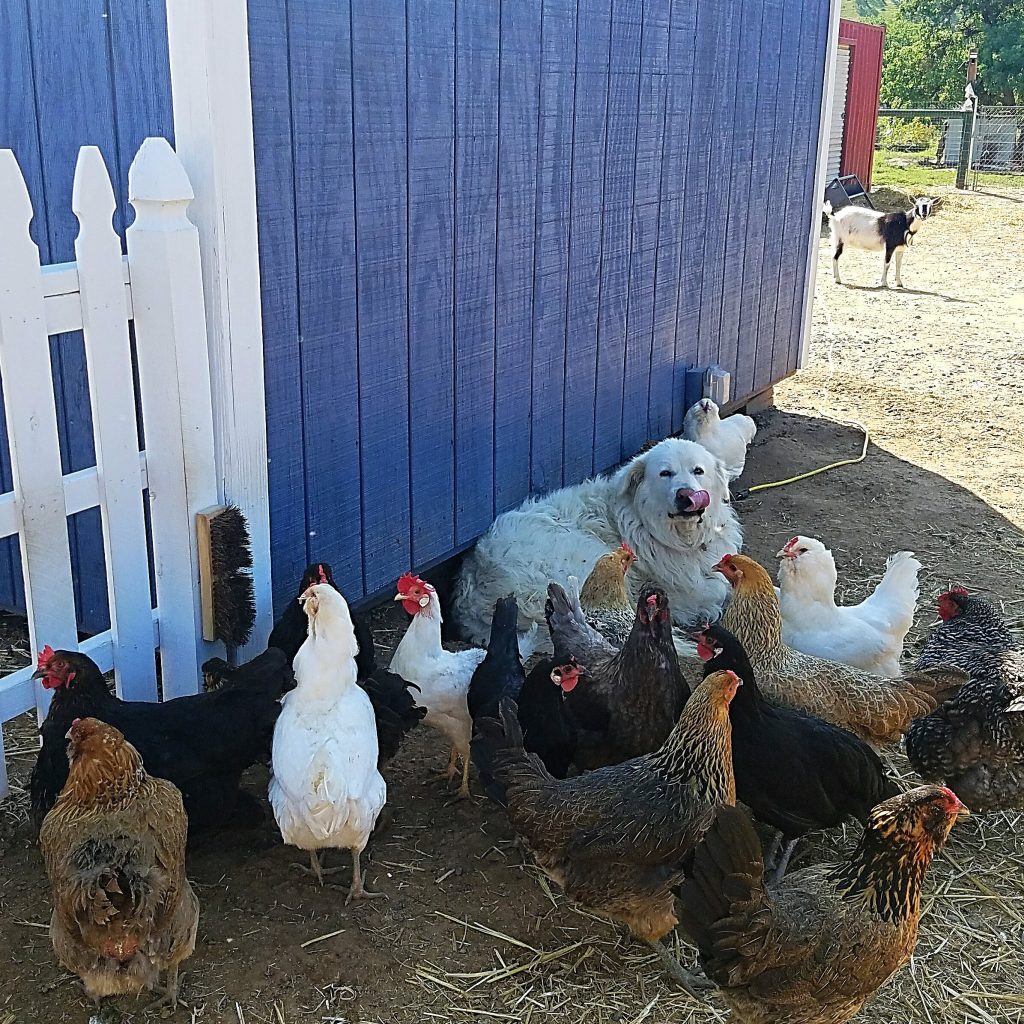
I am often asked about hens for meat, and if we raise them. The answer is yes we have, yes we will again, but we won’t raise chickens that are bred for meat. I will do a post on that soon as I have a lot of opinions about it.
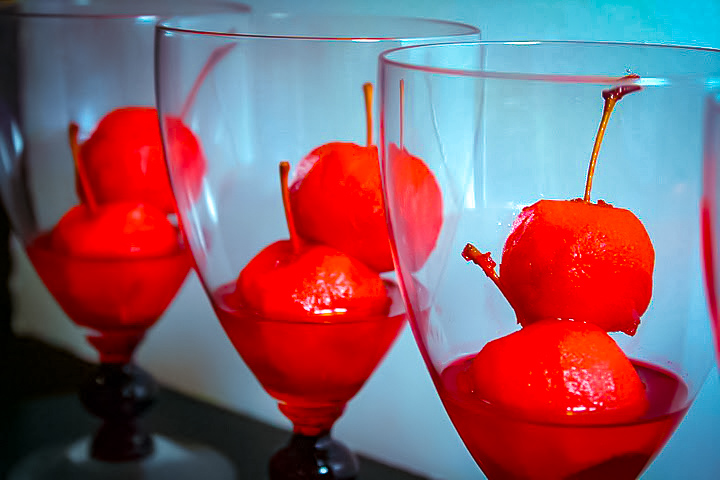
Red Hot Apples
On January 30, 2019 by Christy LarsenMy husband has a
Some time ago we were eating lunch at
It so happens that I am a bit of a
I used standard poaching technique as you would do for pears. Instead of wine, spices, and zest, I used a bag of red-hots.
who knew?
After preparing the warm crimson bath, I thought to check the internet and there are quite a few recipes for cinnamon apples {many using red hots} so I figured I was on the right track.
I imagine these would be beautiful canned in their own syrup, warmed over ice cream, or as an oversized “cherry” crowning a soft warm chocolate cake
Or you can enjoy as we do, one by one; the soft sourness of the crab apple paired with the sticky sweet of the red hot is a lovely combination.
red-hot apples
2 cups granulated sugar
2 cups water
1-14oz bag red hots
pinch of kosher salt
a dozen or so crab apples, peeled (you can core from the bottom if you like
Place the sugar, water, red hots and salt in a heavy pot. heat over medium heat, stirring occasionally to ensure the red hots melt properly (they tend to stick to the bottom of the pan). Once everything is melted, bring the mixture to a simmer and gently plop in the apples. Let simmer for about 15 minutes (these soften quickly, so pay attention). Remove apples and place in a shallow storage pan, cover with hot syrup. Let cool a bit, then store in the refrigerator.
*note…there is quite a bit of extra syrup when all is said and done. you can use it to make more apples, or you can put it in a jar and use it for cocktails.
ps. I took a few of these and put them in a pickling brine with mustard seed and star anise and they made a nice condiment for pork.
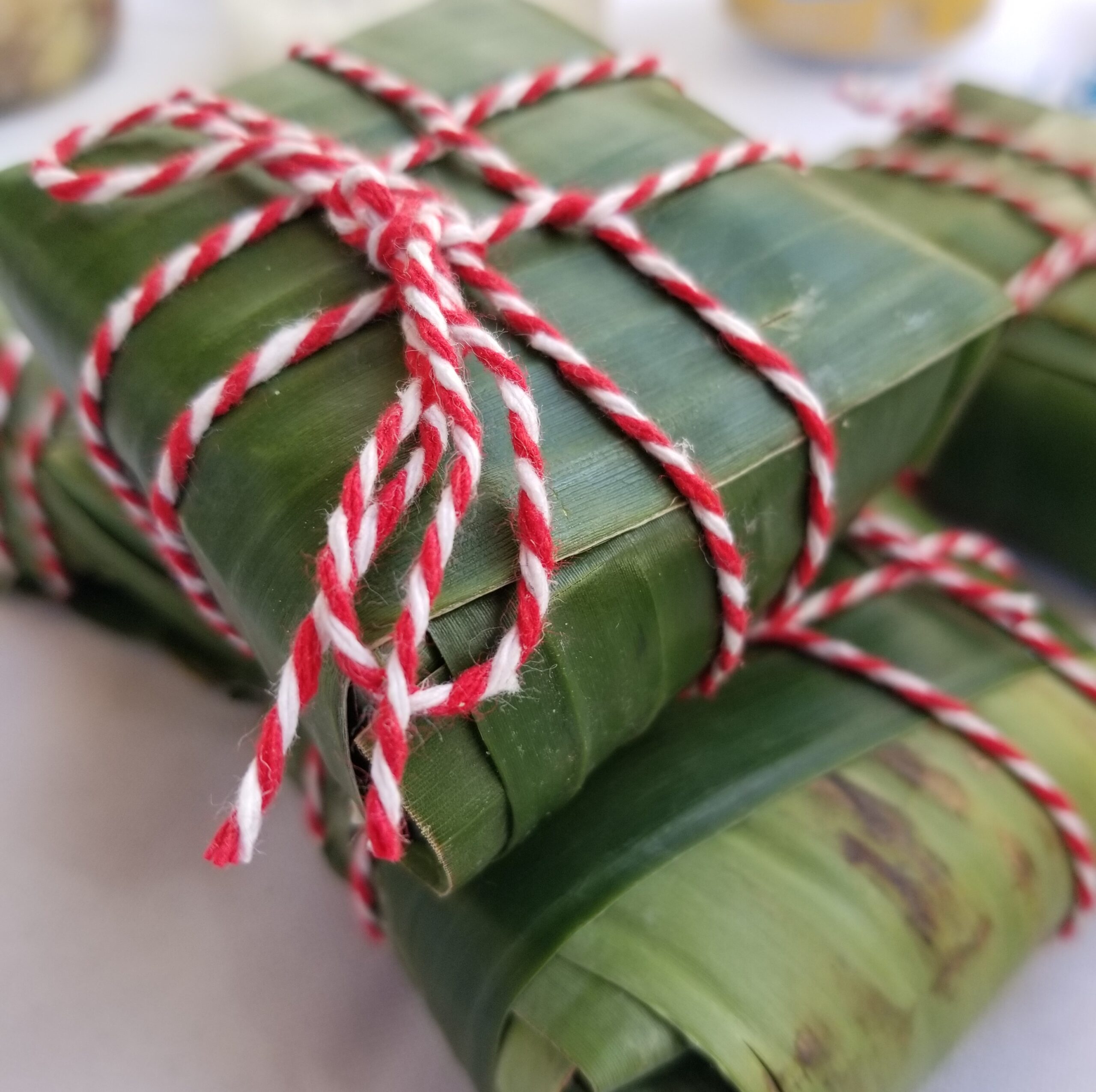
Bahn Chung Collective
On January 28, 2019 by Christy LarsenLast Saturday, for me, the food scene in Los Angeles was a group of people, sitting around tables, learning a new skill and living in diversity.
Truth be told, I was a bit nervous. It was a crowd I’m not a part of; people I share an interest
Food has a way of opening its arms wide and gathering anyone with interest. The women who put this event together; especially Diep Tran, formerly of Good Girl Dinette, were gracious and welcoming and incredibly hospitable. Every element of the day was
We gathered in groups of 8 around shaded picnic tables laden with prepared supplies.
I had been watching, on
After a brief tutorial by Diep, we busied ourselves with the task of making 4 each. One of our table-mates discovered a great hack for “the flip”, another made perfect packages with tiny little bows. Everyone was working together, sharing tips, tricks, and supplies.
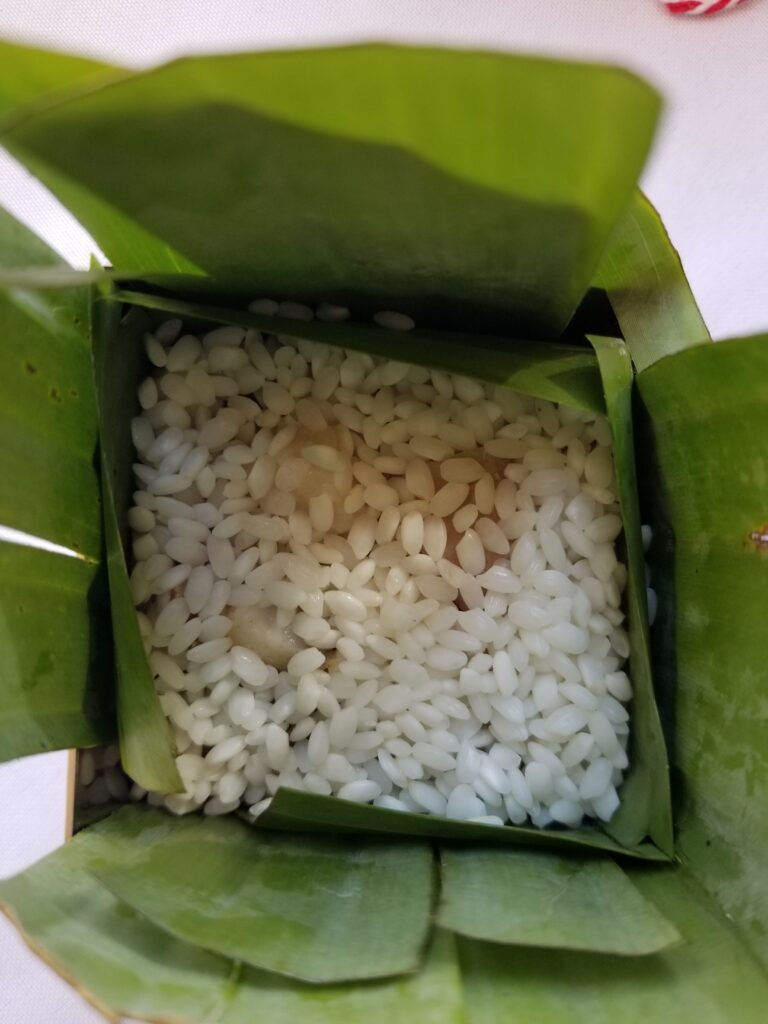
I was a disaster. My space looked as if a toddler had discovered a spoon for the first time. I learned that the foundation was most important. My tip: don’t try and cobble together leftover pieces of banana leaf for your casing; use the good leaves. People say sports are a metaphor for life; I would make the argument that banh
In the end, I had two really nice packets, one mezzo-mezzo, and one unmitigated failure. Imagine my relief when we were given a bag for each of us to keep our own separated. I had been concerned that someone, after working hard all morning, would be stuck with my handiwork at the end of the day.
The day was a bit longer than I had anticipated, but time did pass rather quickly. Our little group of 6 (we had been whittled down from 8 (a strip of
I also left with 2 perfect, 1 mezzo-mezzo and one blown-out and flattened pancake of a parcel. They came out of the pressure cooker, just as they went in; talk about a metaphor for life.
If you would like to learn how to prepare these, there are quite a few videos on youtube. While not the method we used, THIS one will whet your appetite.
I would be remiss if I didn’t also mention that a writer and photographer from the New York Times were in attendance. The story should appear
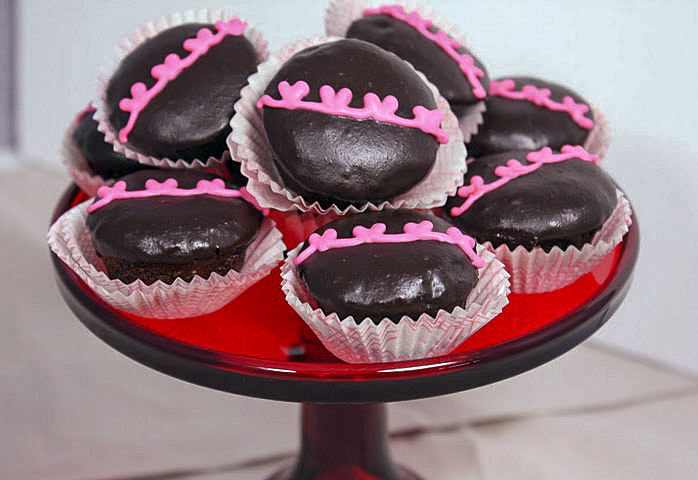
Happy Heart Cupcakes
On January 23, 2019 by Christy Larsen I love it when I make things that look familiar but taste delicious
it is not so difficult when making mock store-bought treats for these hostess-like cupcakes. I use my tried and true devil’s food cake recipe for this; which I also used for my {copycat} ding dongs and instead of
devil’s food cake
3 oz bittersweet chocolate chopped
1 1/2 cups hot coffee or hot water or mixture of the two (i use espresso with water)
3 cups granulated sugar
1 1/2 cups cocoa powder
2 1/2 cups flour
2 tsp baking soda
1 tsp baking powder
1 1/4 tsp kosher salt
3 extra large eggs
3/4 cup vegetable oil
1 cup sour cream + 1/2 cup milk or 1 1/2 cups buttermilk
1 tsp vanilla
Melt bittersweet chocolate in hot water/coffee. Sift dry ingredients together (including sugar). Mix together the chocolate/coffee mixture, milk, sour cream, and vanilla. In a mixer beat the eggs with the oil until thickened and doubled in volume (about 3-5 minutes). Add the dry and wet ingredients, in an alternating pattern, beginning and ending with the dry ingredients. Mix until just incorporated.
Prepare your mini-muffin tins by liberally spraying with baking spray. Bake in a preheated 350F oven. These will bake rather quickly, check after 5 minutes. They are done when the tester comes out clean and the top springs back when lightly touched
creamy fluffy filling
1 cup milk
5 Tbs flour
1 1/4 cup powdered sugar
1/2 cup lard/shortening–room temperature
1/2 cup unsalted butter–room temperature
1/2 tsp vanilla
pinch
salt
Over low heat, cook milk and flour in a saucepan until it makes a thick paste. Use a whisk to break up lumps. Let cool. In
ganache
1/2 lb bittersweet chocolate–
1/2 cup cream
1 Tbs granulated sugar
1 Tbs corn syrup
2 Tbs butter
Heat cream with sugar and corn syrup over medium heat. Once cream begins to simmer and sugar is dissolved, pour over chocolate and butter. Let chocolate melt and then whisk together until it is thick and shiny.
For Royal Icing, I use Martha Stewart’s recipe. You can find a link to her recipe HERE
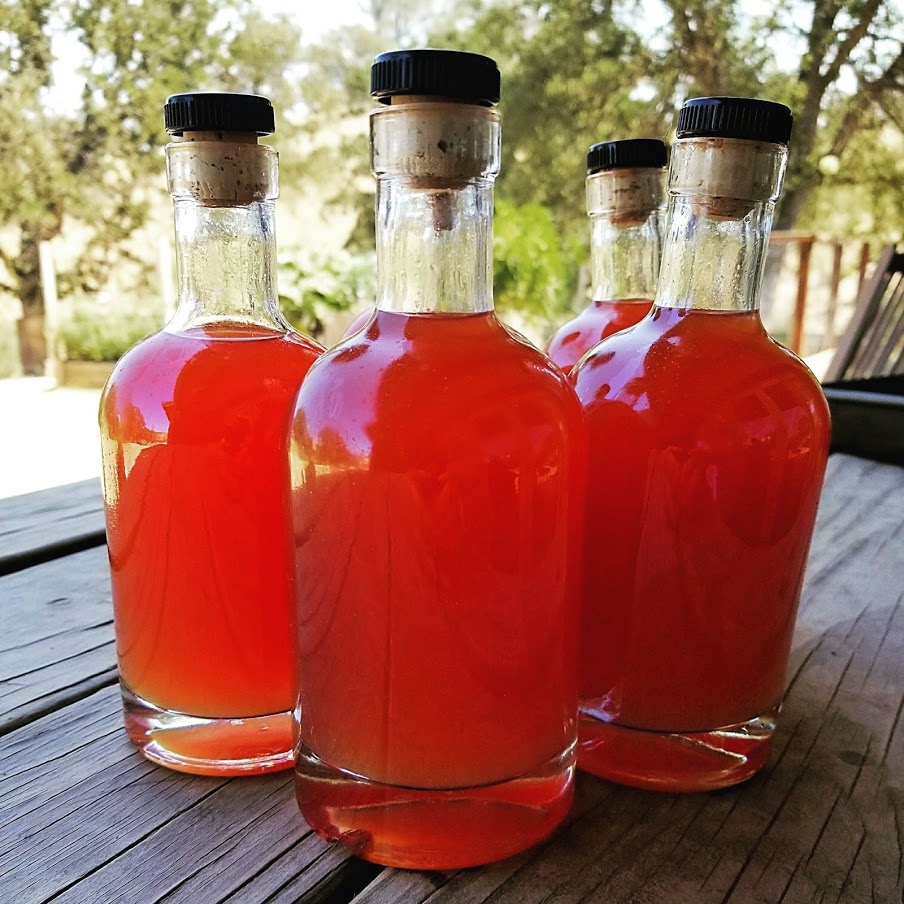
Citrus-Cello
On July 5, 2018 by Christy LarsenI always have a citrus-cello project in the works. It is the final resting place for all the excess citrus that we grow and gather. I currently have a limoncello & arancello in the works. Limoncello is an Italian digestivo, that is most popular on the Island of Capri…but can be found all over Italy, and now the States as well. Arancello isn’t quite as popular, nor is it as authentic, but I love it anyway. It is a delicious liqueur and has many uses beyond drinking. I, for example, toss it into my homemade jam just before canning and often use it as a soak for my olive oil cake. Although making this takes passive time, it’s really easy…and makes a wonderful gift. Start now for the holidays.
You need lots of fruit–use lemons, blood oranges, mandarins, grapefruit, whatever you have on hand. We mostly use the peel, but will also need to juice the fruit and store it for later.
Waste not, want not; so here are some ideas for the rest of the lemon:
Cut in half, pour some salt on it and tame your elbows (Barbra Streisand does it and so should we).
Juice the lemons and make the required sugar syrup in advance (but keep it in the freezer, so it doesn’t get weird).
Make lemon curd…better yet, make lemon chicken…ooh what about lemon bars? Those are my fave.
Back to the recipe. Wash and dry about 10-15 lemons {or fruit of choice}. The lemons should be unwaxed. Remove the peels. Now, this is very important…you do not want the pith. That is the white stuff that hugs the peel like a preschooler hugs his mom on the first day of school. Remove it all…you only want the yellow part. The pith is bitter and is not good for your end result. Place all the peels in a large glass or ceramic jar with a tight-fitting lid. Pour 1 bottle of vodka or grain alcohol over it. You do not need expensive vodka for this, you want the alcohol content, but the theory is that you will be changing the flavor of it, so don’t break the bank on this one.
Put the top on the jar, date it, and put it away in a cool dark place for a minimum of 2 weeks but as long as 3 or 4 months. I tend to steep mine for a long time; mostly because I forget.
When you see that all of the lemon peels have lost their color and/or it’s been at least 2 weeks you can move onto the next step.
In a heavy saucepan place 3 cups of water, 1/2 cup of strained lemon juice, 3 cups sugar and 3 Tbs honey. Boil over low heat until the sugar is completely dissolved and the mixture is clear. Don’t let it go too long and get thick and gooey. Let cool.
Pour the syrup into your glass jar with the lemon peels and vodka. Cover and let steep for another week (or longer if you have the time). When you are ready to bottle your limoncello, strain the liquid using cheesecloth or fine sieve. Squeeze all that you can from the peels and then throw away (or roll in sugar and dehydrate for a sweet and boozy garnish). Bottle the liquid in clean jars and seal tightly.
Like revenge, this is best served cold…store it in the freezer.

Gingerbread Marshmallows
On June 28, 2018 by Christy LarsenRoasting marshmallows is a year-round sport in my house. Sometimes, I just turn on the stove burner, load a fork, and fire away. Normally, eating ‘mallows out of hand is not my thing…I like a charred exterior and molten center. I do make an exception with these, as they are so good au natural, lightly toasted and dipped in chocolate, or as a float on your favorite hot beverage {even tea…especially tea}.
Gingerbread Marshmallows
3/4 oz gelatin
1/2 cup cold water
1 1/2 cups granulated sugar
1/2 cup dark brown sugar
1/4 cup water
2 Tbs molasses
1/4 tsp kosher salt
1 tsp ground ginger
1 tsp ground cinnamon
1/2 tsp ground clove
2 egg whites
Put sugars in a saucepan. Add 1/4 cup water to make a mixture that looks and feels like wet sand. What is most important is that all sugar has the same amount of moisture. Add molasses, salt, ginger, cinnamon and clove, and place over low heat. Cook until it becomes a sugar syrup of 235-240 degrees. It should have the consistency of corn syrup.
Meanwhile…place 2 room temperature egg whites into the bowl of your mixer. Add the salt .
Prepare gelatin. Place 1/2 cup water in a bowl. Sprinkle the gelatin evenly over the water. Let bloom.
Once the sugar syrup is ready, turn off heat and let sit for a couple of minutes…not too long. Start your mixer on low and get the whites to foamy. Mix the gelatin into the sugar syrup and stir until melted completely. Bring the saucepan over to the mixer and turn it to high. Slowly pour the sugar syrup into the bowl, careful not to hit the whisk attachment. Leave on high and mix until the mixture is warm, but full volume and comes to a peak. While it is still warm, pour into tin or pan. Sift powdered sugar on top. Cut into squares and store in airtight container.
These are yummy tossed into a cup of hot cocoa and a real grown up treat when toasted and sandwiched into a s’more.
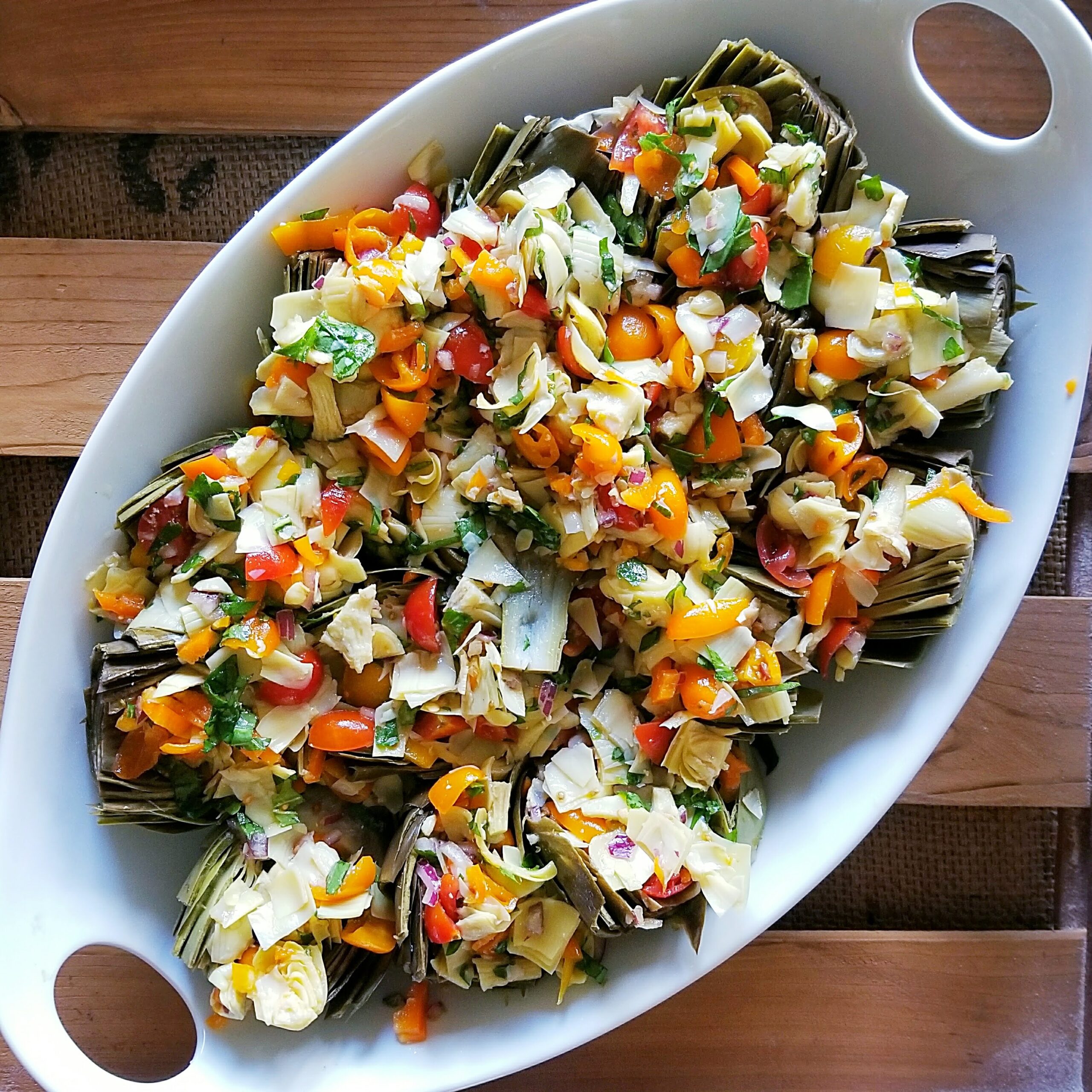
Artichoke Stuffed Artichokes
On April 9, 2018 by Christy LarsenWhen it starts to warm up, and spring is in full swing, we dine alfresco. Our tiny house doesn’t have a dining room, and our “table for two” is never large enough for the number of people eating on any given day. So we take it outside.
Eating outside is wonderful but has some drawbacks; like keeping hot things hot. This is why I shift my cooking to things that are best served at ambient temperature. Unless we have cocktails prior to dinner; because if we have cocktails, then no one really notices that the steak is a bit cold.
One of my favorite dishes is this artichoke stuffed artichoke salad. It is very simple, and is a wonderful way to use up those half-full jars of pickled and marinated veggies in your fridge.
-Wash and trim artichokes and place them in either a steamer or a pan/pot of water with a lemon or two squeezed in it. Don’t fully immerse the artichokes, but use enough water that it won’t evaporate completely before the artichokes are cooked. Place on medium heat and cook covered until you can easily pull a leaf off. Remove from heat, drain and let cool.
-Cut the artichoke in half and use a spoon to remove and discard the choke {the part that has those hairy bits}. Lay the artichoke halves on a platter face up {or alternatively, you can brush with oil and char on the grill, then place on a platter}. Dress with a bit of your favorite vinegar and olive oil. Set aside
-In a large bowl combine your salad ingredients. I like to use, canned artichoke hearts, tomatoes, roasted peppers,red onion, celery, olives, fresh bell peppers, and any cooked rice or barley or grain I have in the fridge. You can use virtually anything you have hanging in the fridge or pantry. Toss together with oil, vinegar, salt and pepper and place a generous scoop into each artichoke half.
-Serve cold or room temperature
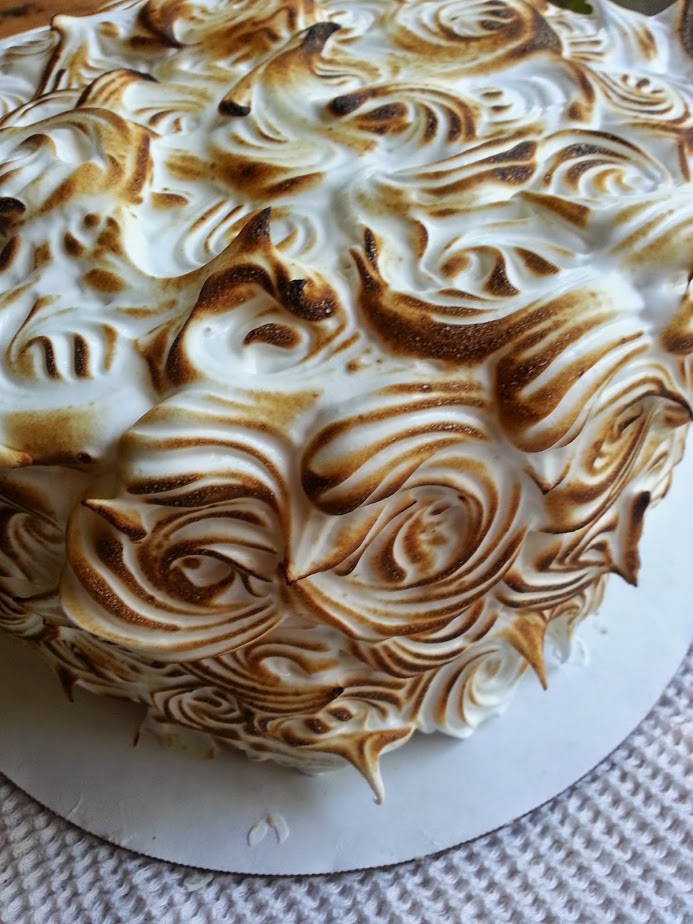
Ten Layer Lemon Meringue Cake
On April 8, 2018 by Christy LarsenLet me get something off my chest; I have a problem with layer cakes that are 3 inches of cake for every 1/4″ of icing. My ideal is {in equal measure} cake, icing, cake, icing ..and so on and so forth until you run out of both. I want layers upon layers that are none too dry or too sweet. It makes it difficult to have perfect sides, and 30 second videos of the perfect spin and frost technique. But it tastes good. Perfect is fine, but delicious is divine.
I first put together this cake for a dear friend’s 80th birthday almost a decade ago. It has become a family favorite. It is perfect all year ’round, but I like to make it when lemons are at their seasonal best.
Lemon Meringue Cake
Cake Layer
{from Nick Maglieri}
3 cups all purpose flour
3 tsp baking powder
1/4 tsp kosher salt
18 Tbs unsalted butter–softened
2 1/4 cups sugar
1 Tbs vanilla extract
9 lg egg whites
1 1/8 cups milk
reheat oven to 350. Whisk together flour, baking powder and salt in a bowl. In a mixer, fitted with paddle attachment, beat the butter and sugar until very soft and light. Whisk together the milk, egg whites and vanilla until just combined. Reduce the mixer speed to low and alternately beat in the flour and milk in 4 batches; starting and ending with flour. In order to not over-mix, do not fully incorporate each addition before adding the next one. Scrape down the sides in between each addition.
I bake this off in thin layers, making it easier to stack when putting the cake together. You can make 2 layers and slice into thin layers, if you prefer…but I like taking the time to bake off thin layers that make assembly a bit more fuss free.
This will make 6-7 thin cake layers. Each layer should be less than 1/2″ thick–i use approximately 3/4 cup batter for each layer.
Spray 9″ cake tins with pan spray and place a circle of parchment in the bottom. If you only have 2 pans, you will have to wash in between bakins. Bake each layer approximately 10 minutes, but carefully watch, as the layers are so thin, they will brown easily. Once you pull the pan from the oven, wait a few minutes, then turn out onto parchment. Wash and dry the tins, then start the process again. Let the layers cool completely. {can be made a day ahead and stored at room temperature, or well ahead and frozen}
Lemon Curd
grated zest from 1 lemon
3/4 cup lemon juice
1 1/4 cup sugar
12 Tbs unsalted butter–cut into small pieces
12 large egg yolks
Whisk the yolks, sugar, lemon juice and lemon zest in a bowl. Place bowl over bain-marie and cook, stirring continually until the liquid thickens to a nappe {coats the back of the spoon and retains shape when you swipe your finger down the middle}. Do not let it boil, as the eggs will scramble. Remove from heat and pour through a sieve into a clean bowl. Toss in the butter while the curd is still hot. Stir until the butter is fully incorporated. Cover with plastic wrap placed directly on top of the curd. Refrigerate until cool and set. {Can be made a day in advance}
Lemon Italian Buttercream Icing
{if you have a favorite icing, use it and add the lemon curd and whip until creamy}
1 cup granulated sugar
1/4 cup water
4 egg whites–room temperature
2 cups unsalted butter–room temperature
1 tsp vanilla extract
1/2 tsp salt
about 1/2 cup lemon curd {this is to taste, it depends on how lemony you want your buttercream}
Place egg whites and salt in the bowl of an electric mixer fitted with whisk attachment. Combine 3/4 cup of the granulated sugar with water in heavy saucepan and bring to a boil over medium heat. Continue cooking until it reaches 235F (just before soft ball stage).
Meanwhile, while the sugar is boiling, begin whisking the egg whites. Once, frothy, “rain” in the remaining 1/4 cup sugar. Whip to soft peak. When syrup reaches 235F remove from heat (it will continue to get hotter and reach the desired 240F). With the mixer on medium speed, begin immediately pouring the hot syrup into the egg whites. Be careful not to hit the whisk directly. Once all the syrup is incorporated, kick the speed up to high and whisk until it cools to room temperature.
Change the attachment from whisk to paddle, and begin adding butter, a few bits at a time. Once it is all incorporated and it looks like buttercream, mix in the vanilla and curd (to desired flavor)
-can be made several days in advance
Meringue
3 large egg whites–room temperature
1/4 tsp cream of tartar
3/4 cup granulated sugar
1/2 tsp vanilla
pinch salt
Make sure the beater and bowl are extremely clean and free of any oil or fats. Beat whites on low until foamy. Add salt and then kick up the speed to medium. Add cream of tartar. Beging to slowly add the sugar “raining” it into the egg whites. Continue to beat until soft peaks form, then add vanilla. Beat to stiff and firm peaks.
If you over-beat, you will see moisture starting to “weep” from the whites. If this happens, start over!
-must be used day it is made
PHEW! –now that you have all the elements, you can start building your cake
To Assemble
Place 1 cake layer on a round cake board. Pipe buttercream around the edge of the cake making a dam. Fill with lemon curd. This curd is quite tart, so you don’t want to over-do it. Also, your filling should not be thicker than your cake layers. Place another cake layer on top of the curd. Pipe a layer of buttercream. Continue with cake, buttercream dam & curd, cake, buttercream, cake….until you run out of cake layers. the top layer should be cake. Refrigerate until cold and firm. You can cover with plastic wrap and refrigerate for 24 house. When ready to finish and serve, cover in meringue (i have piped swirls), and hit with a torch to brown the edges. I do not recommend using the oven as the buttercream and curd will melt quickly.


